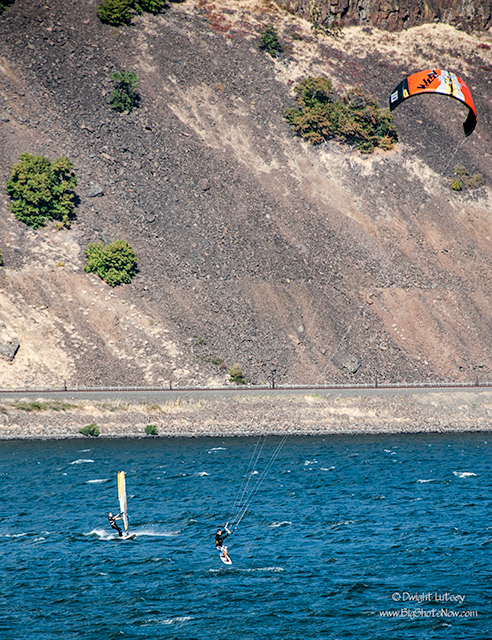There is an area of the Columbia river that is bounded on one side by I-84 and the Mosier-The Dalles highway and by the Lewis and Clark highway on the other side. It is a narrow spot on the river made more so by the high cliffs on either side which forces the river to run faster and have very choppy water. It also forces the wind, which blows through here screaming like a banshee, to funnel through this valley at a very constant rate. It is located in the Cascade Locks area of Oregon and the border between Washington and Oregon runs right down the middle of the river, invisibly dividing it in two.
I saw these individuals on the river performing activities that I had never seen before, so as an investigator of new phenomenon I was duty bound to stop and, well, investigate. I wanted to find out as much as I could about this strange waterborne behavior. Luckily there were local experts there that were eager to fill me in on the facts.
My questions were quite pointed. “Why do people do this?” “Is there any useful purpose being accomplished here?” “What kind of glue do you use to hold your feet to the board when you leave the water?” “Does it bother the fish to have someone jumping up and down on their roof?” Amazed at my questions and after learning that I was on a fact-finding mission and would be reporting their answers to the world at large through this blog, they virtually fell all over each other to give me the straight story. Setting down his 40oz can of Olympia one thoughtful fellow looked at me and began to tell me about how they were involved in a major environmental struggle to contain the mighty Columbia river and prevent a catastrophic event that could endanger half the western Pacific.
It seems that in times past the Columbia ran down to the sea completely unchecked. There was nothing between its origin and the Pacific ocean to control its riotous, mad dash to the sea. As it did so it’s level would rise to startling but dangerous heights. Countless times trees were uprooted and sand bars washed away, creating mini-environmental disasters. Fish were disoriented and couldn’t tell upstream from down and consequently were swept out to sea to die a horrible death by drowning. Native Americans were fearful of throwing their nets into the river, less they too, would be dragged down to Portland and suffer the fate of being exposed to the white people’s sinful ways in the strip clubs and gin mills of the inner city. It seemed that natural chaos reigned and something had to be done.
The answer was obvious after a fortunate accident occurred. A carpenter named Phil, fell while carrying a plank across a dock and landed on the river astride the wide board. Knowing of the dangers in reaching Portland he immediately removed his shirt and by holding it by its arms to try and flag down help, watched in amazement as it filled with the strong winds of the Columbia gorge, becoming a sail which he could safely guide his way back to shore.
Soon carpenters were falling in the river with their planks at an alarming rate until all you could see was a field of flag waving, wide board carpenters filling the gorge from one side to the other. It was then that the real discovery was made. A waterman whose main job it was, was to watch the water for suspicious activity, noticed that the more carpenters they piled on the river the lower it got. It was one of those eureka type moments that those Oregonians are noted for. It wasn’t long before the discoveries of jumping up and down tamped the river down, as it were and packed it to a more acceptable level. It was also noted that you didn’t need carpenters to do this. Almost anyone with a minimum level of brain cells could be trained to strap on a sail and go out and ‘Tamp the River’.
Today, right now in fact, if you’re driving down the gorge you can see swarms of maintenance crews out there, sails in the air, boards on their feet, tamping the river for all their worth, keeping it at acceptable yet safe, levels. Yes their gear has changed. No longer do they use the heavy old pine planks of days long gone, nor do they rip up perfectly good shirts to make their sails. Everything is poly-this and Poly-that and the brighter the better although I think that is more due to them not wanting to be hit and sunk by the pesky freighters that sail up and down the channel.
The old salt that was telling me this looked me in the eye and said with a perfectly straight face, “and that’s why we do what we do”. I couldn’t write fast enough. To be able to get the hidden story that isn’t shared with the public at large was an honor. It isn’t often that the truth gets shared as honestly as this and I was more than glad to pay for the next case or two of Oly’s as they called them. The old salt simply smiled at me and I almost felt as if I were taking advantage of them because now I had a story that I could tell that hadn’t been heard before and how could you put a price on that.


You must be logged in to post a comment.